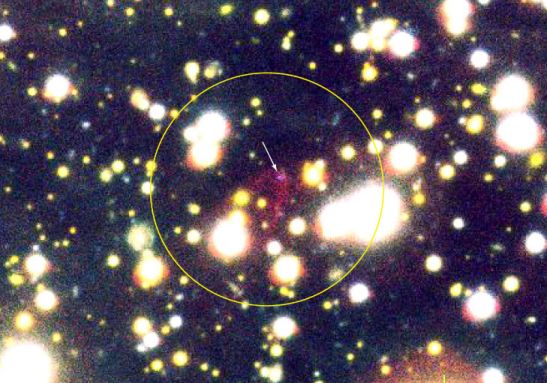Credit & Copyright: M. van Kerkwijk
(Institute of Astronomy, Utrecht),
S. Kulkarni (Caltech),
VLT Kueyen, ESO
Explanation:
The
lonely RX J1856.5-3754 was formed
from the collapsed core of an exploding star.
At a distance of 180 light-years it is the
closest known
neutron star.
More massive than the Sun but only
20 kilometers across, this tiny stellar juggernaut plows
through the hydrogen gas and dust clouds of interstellar
space at about 200 kilometers per second.
The surface of the
neutron star
is fantastically hot, around 700,000 degrees Celsius, making it
detectable with
orbiting x-ray telescopes.
But optical astronomers were
recently surprised to discover that RX J1856.5-3754 is also surrounded
by a cone-shaped nebula.
Indicated in this deep image from the European Southern Observatory's
Kueyen telescope, the nebula glows
in the red light of ionized hydrogen atoms
recombining with electrons.
Its cone shape is analogous to the
bow wave of a ship plowing through water.
A faint blue dot near the tip of the cone
is the neutron star itself.
The nebula appears to have formed very near
the
surface of the
neutron star and astronomers are trying to determine if the
observed densities and temperatures can indeed explain the
nebula's appearance.
1999 2000 2001 2002 2003 2004 2005 2006 2007 2008 2009 2010 2011 2012 2013 2014 2015 2016 2017 2018 2019 2020 2021 2022 2023 2024 2025 |
Январь Февраль Март Апрель Май Июнь Июль Август Сентябрь Октябрь Ноябрь Декабрь |
NASA Web Site Statements, Warnings, and Disclaimers
NASA Official: Jay Norris. Specific rights apply.
A service of: LHEA at NASA / GSFC
& Michigan Tech. U.
|
Публикации с ключевыми словами:
nebula - эмиссионная туманность - нейтронные звезды - bow shock - emission nebula - головная ударная волна - neutron star
Публикации со словами: nebula - эмиссионная туманность - нейтронные звезды - bow shock - emission nebula - головная ударная волна - neutron star | |
См. также:
Все публикации на ту же тему >> | |
